Since our debut issue, exactly nine years ago, Whitewall has featured both studio visits and contemporary art collections—always separately. But while spending time with artists in the intimate spaces where they work, we’ve noticed that they surround themselves with some pretty wild objects of inspiration and, sometimes, the work of their peers. Eventually, it became obvious that most living artists are collectors of something in their own right. So, we thought, why not ask these innate aesthetes about what they collect, as well as what they create?
For this new kind of feature, we’ve committed ourselves to catching up with the leaders in contemporary art—discussing the works, souvenirs, trinkets, and trophies they’ve gathered together throughout their lives, and finding out how those collections inform the work they produce as professional artists. To kick off the series, Whitewall met with #instafamous Daniel Arsham in his Greenpoint studio, where he shared with us his collection of vintage film equipment, his roots in photography, and his new film, The Future Relic.
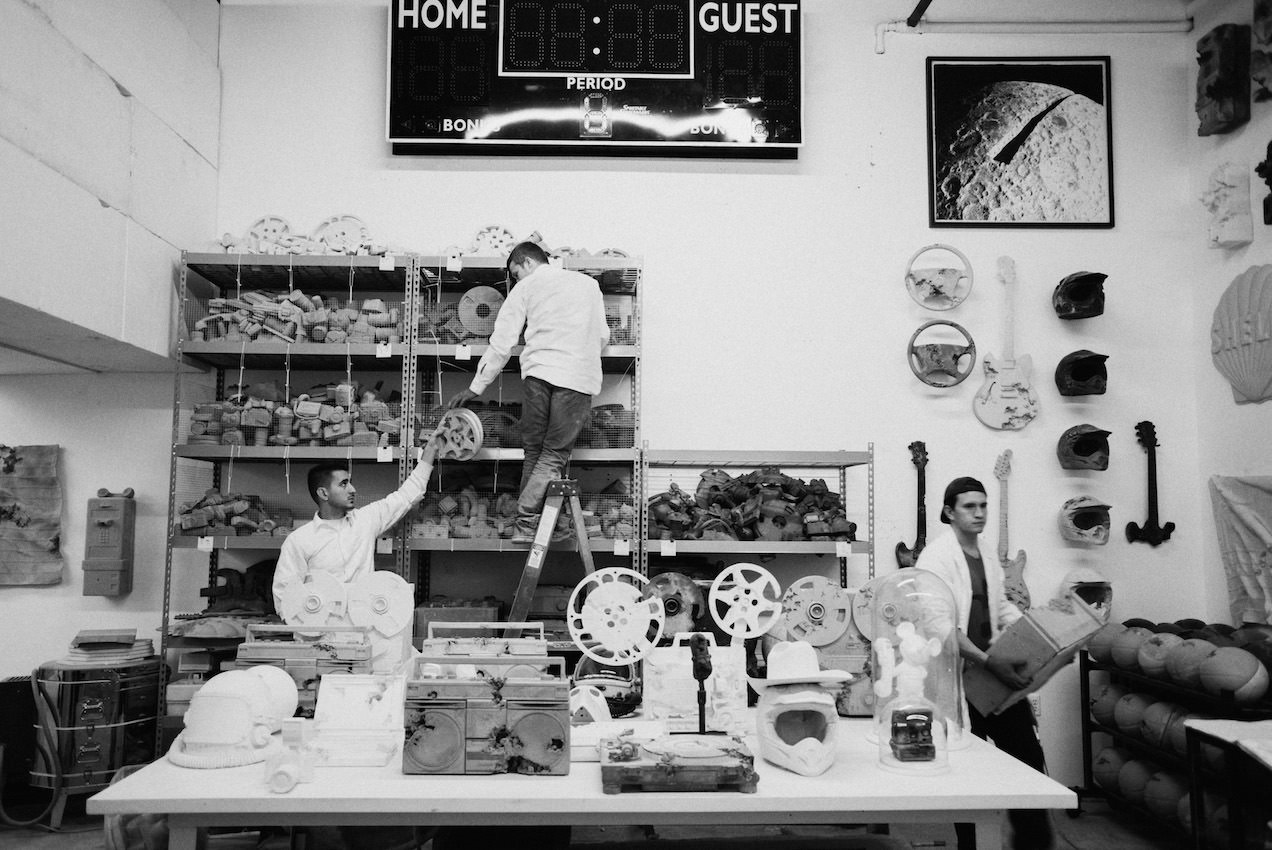
Photo by Shawn Brackbill
Arsham graduated from Cooper Union in 2003 and began carving out his career as an artist in his hometown of Miami. But it was his 2006 to ’07 collaboration with the modern dance choreographer Merce Cunningham that propelled his meteoric rise to fame. Since then, he’s founded his architectural practice, Snarkitecture, with Alex Mustonen, produced sculptures with Pharrell Williams, signed with the illustrious Galerie Perrotin, and racked up 176,000 Instagram followers (and counting). While his monochromatic sculptures of iconic Americana in various states of decay have become a staple of his oeuvre (and feed), the colorblind Cleveland native sees nothing but an expansive interdisciplinary future for his work. As one looks at his collection, Arsham’s prolific practice begins to slide into focus.
“Photography was the first thing I made that I felt could be a piece of art. Before I made paintings, before sculptures—anything, really—it was photography,” the soft-spoken artist explained as we sat down beside two dozen vintage cameras. Lined up like little soldiers on a sparkling white work table, Arsham’s collection of relics of photo and film history looked more like the subject of some futuristic science experiment than dusty debris lying about your nearest thrift shop.
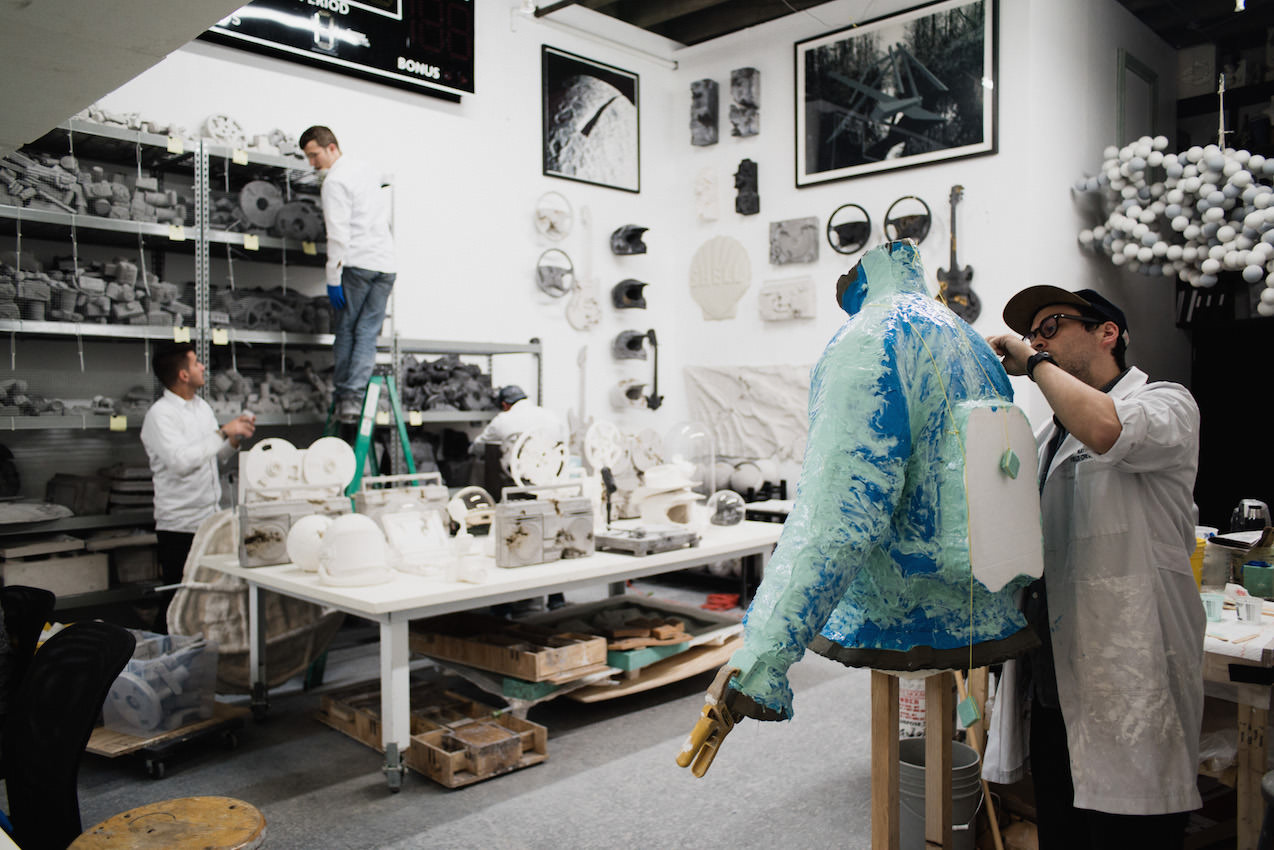
Photo by Shawn Brackbill
“Confusion is something I use a lot in my work,” Arsham remarked. It’s apparent.
A snapshot of his studio could easily be mistaken for a state-of-the-art research laboratory. Like a seasoned method actor, the artist has completely immersed himself in the premise of his work; particularly in relation to his “future archeology” series, for which he imagines himself as a futuristic scientist, uncovering technological artifacts from our present.
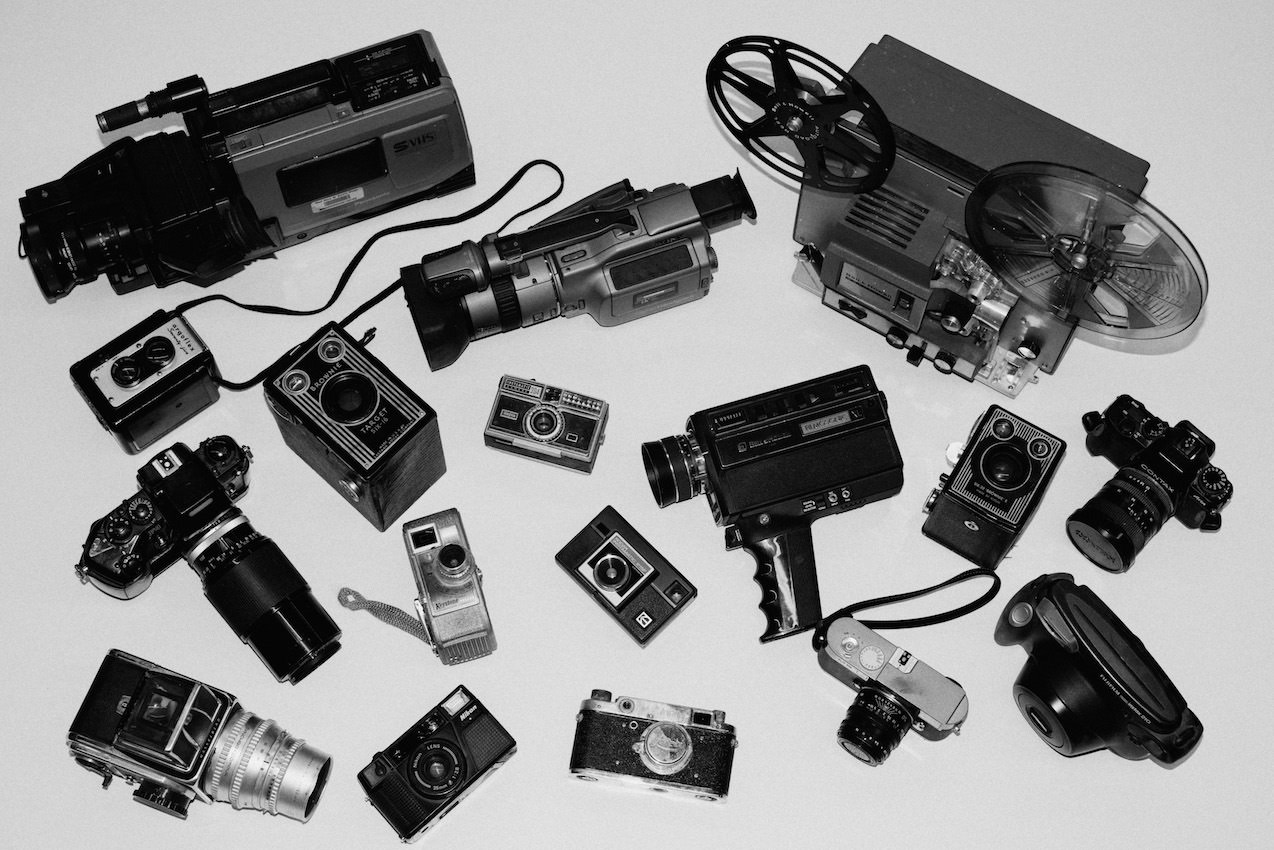
Photo by Shawn Brackbill
The mise-en-scène: Assistants in white lab coats and safety goggles hurried about the studio, producing monochrome sculptures of iPhones, basketballs, and boom boxes in ash and crystal with military precision. Arsham was sporting a white lab coat, too, and his signature steel-rimmed glasses completed the whole chic mad scientist look. As the conversation turned to his childhood, he slid his specs up his nose and plucked a camera off the table.
“This was the first camera I ever owned.” Arsham was holding a Pentax K1000 (an interchangeable lens, 35mm, SLR camera, manufactured by Asahi Optical Co. from 1976 to 1997). “I had asked my father for it, and when he gave it to me I just remember thinking, as an object, it was so beautiful. It was manual. So in the age of disposable point-and-shoot film cameras that you used to drop off at the drug store [to develop], this was something that required an investment to learn how to use it, to think about light.” He recalled, “That was 1990. It was my tenth birthday.”
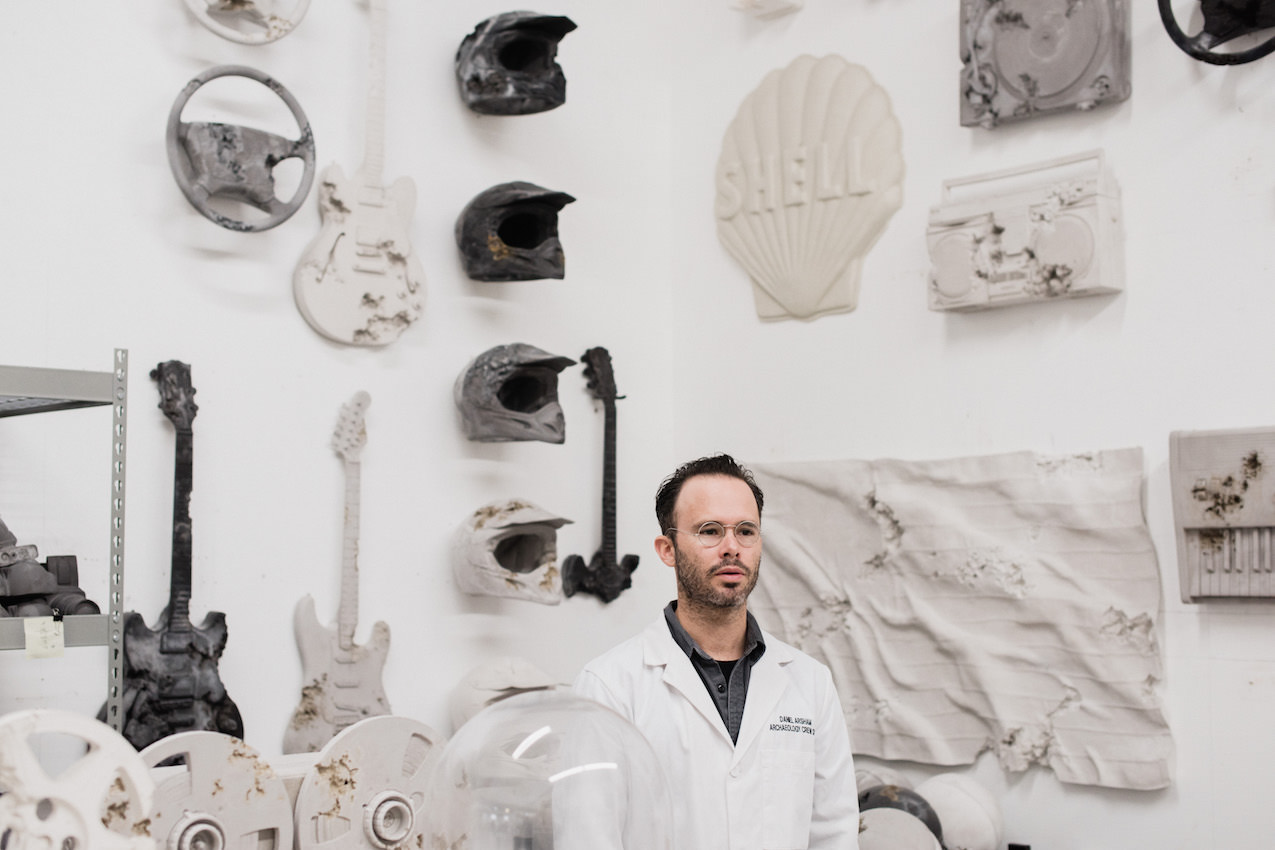
Photo by Shawn Brackbill
Ever since, Arsham has treasured his cameras. Like most of us, the artist typically discarded outdated tech over the years, replacing an old phone or computer with the ever-improving model. But Arsham always held onto the cameras he acquired growing up, somewhat unwittingly building a collection since 1990. In an age when grainy BlackBerry uploads on Facebook incite nostalgia, Arsham’s earliest photographic acquisitions look practically ancient.
Since 2010 he’s been buffing up the collection, trolling eBay for vintage cameras and incorporating new acquisitions into his sculptural work. “I’ve made molds of almost everything here,” he noted, motioning nonchalantly toward the table. “I look for cameras that are recognizable, but nonfunctional, because often the originals are destroyed in the mold-making process. Like this piece,” he said, reaching for a seemingly well-kept Hasselblad as a visual aid. “In order to make a mold of this, all of these seams, every single area where all the material could seep inside has been filled with clay, which obviously renders the original unusable. That’s why I want broken cameras. I don’t want to take too many of these things out of the world.”
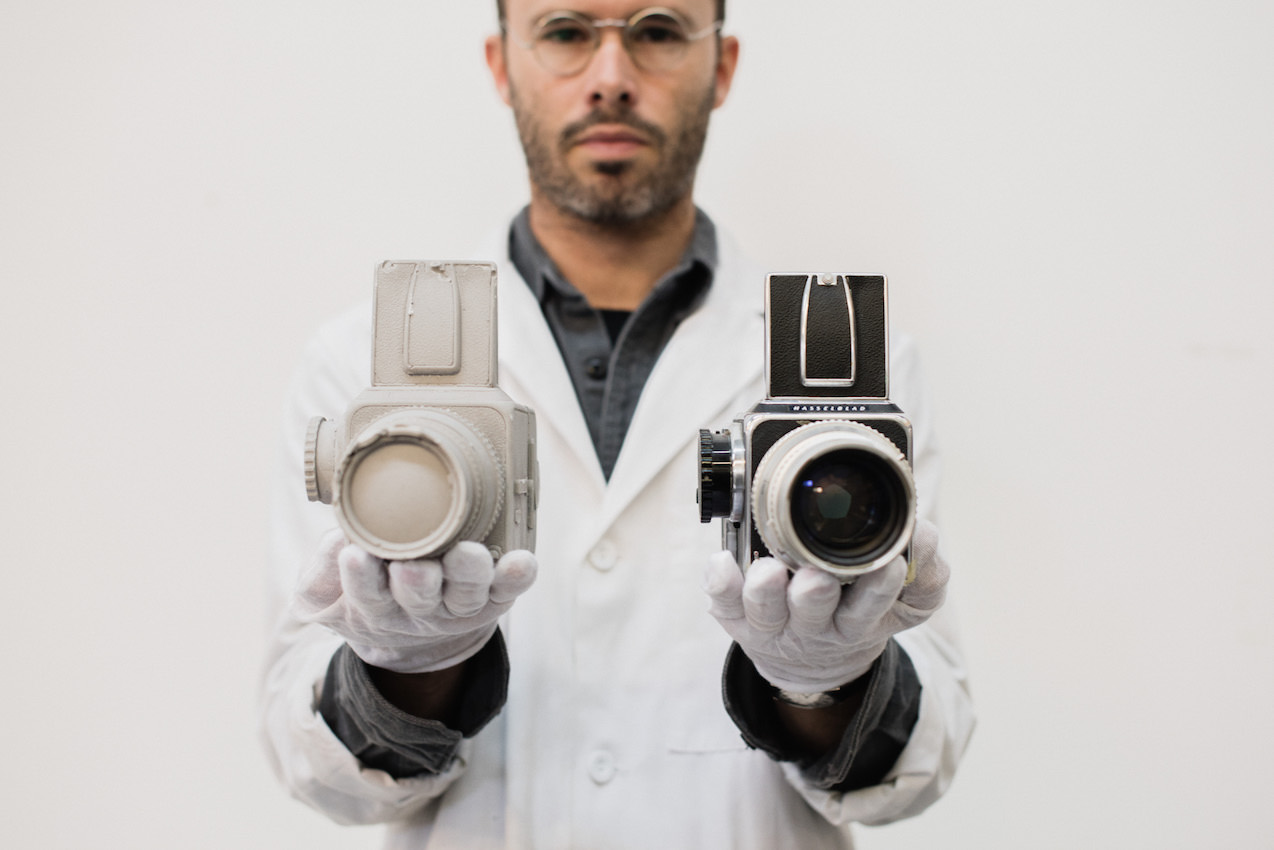
Photo by Shawn Brackbill
A born photographer, Arsham has a respect for these objects that derives as much from their function as their technical semiotic significance. Long before he cast the collection for his “future archeology” series, Arsham used his cameras to capture some of the most significant events in his life. In August of 1992, just two years after the young artist began to think actively about image making, Hurricane Andrew hit Miami. The massive destruction inflicted by Andrew, followed by a rush of large-scale rebuilding projects, made for some dramatic changes in the urban visual landscape. Just 12 at the time, Arsham was “nearly killed” in the storm and in its wake, and looked on through the lens of his Pentax as the devastated city quickly attempted to recover.
Arsham described the images from Andrew’s aftermath as “a child’s view of disaster.” To this day, the photographs remain cards he plays close to the vest. “I still have them and I look back on them often. But I’ve never shown them. I’m still not ready.” While the artist’s boyhood photographs remain shrouded in mystery, it’s clear from his work as a professional artist that living through the storm had a direct impact on his creative output. Early sculptures made from shattered glass, architectural stairs that lead to nowhere, and plaster walls that appear to ripple and melt practically spell out “n-a-t-u-r-a-l d-i-s-a-s-t-e-r.” Admirably, these structures avoid the appearance of a city in ruins. On the contrary, Arsham’s clean, monochrome aesthetic and sophisticated technical execution matter-of-factly position the work as legitimate alternatives to the quotidian walls, windows, and doorframes one would normally expect.
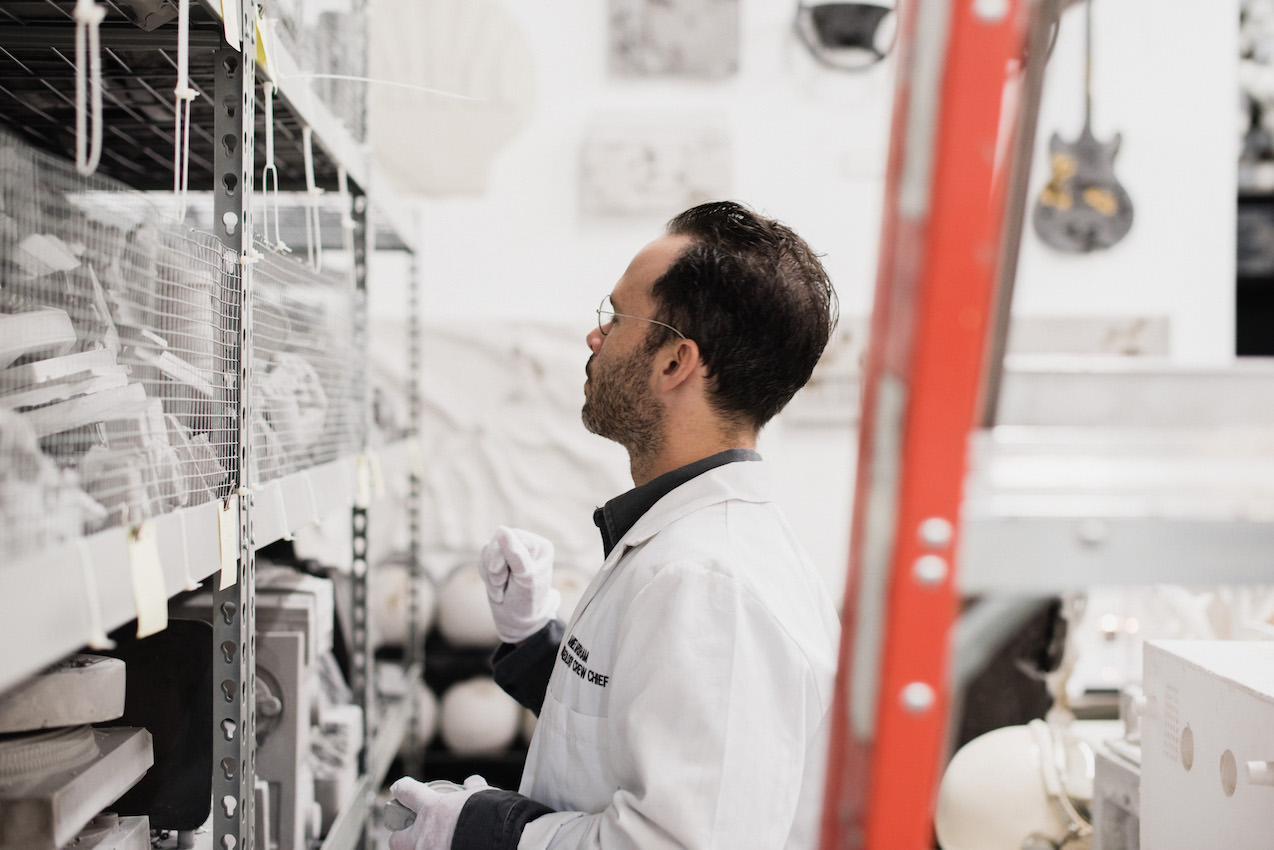
Photo by Shawn Brackbill
Playing with this idea of articulated confusion, in 2010 Arsham began creating his well-known “future archeology” series. He had just returned from Easter Island, the remote Polynesian territory known for its monumental Moai statues. “You know, those big stone heads they’ve got there?” he continued. “Well, while they were excavating one, these archeologists discovered antique archeological tools at the site. They realized that another team of scientists had been there a hundred years ago. There was this very strange confusion of time between this sculpture that was a thousand years old and these hundred-year-old tools.” Upon his return to New York, he set to work creating a sculpture he felt could elicit that same “strange confusion of time” he had experienced at the dig. Using volcanic ash brought back from his trip, he cast a sculpture of his very first camera, “that Pentax K1000 from my father.”
Arsham is more deliberate than sentimental, and his aesthetic decisions build meaning like a row of Russian dolls in an infinity mirror. Like archeological tools, cameras are used to document and preserve a moment in history. As implements of preservation, both quickly outdate themselves. “I started the series with cameras because the camera was the first object for me, and for many people that speaks about technological advancement,” he explained. “This interest in fictional archeology, in casting technological things, evolved out of that experience on Easter Island. It wasn’t actually until after I cast the Pentax that I got online and began actively collecting these pieces as subjects for the work.”
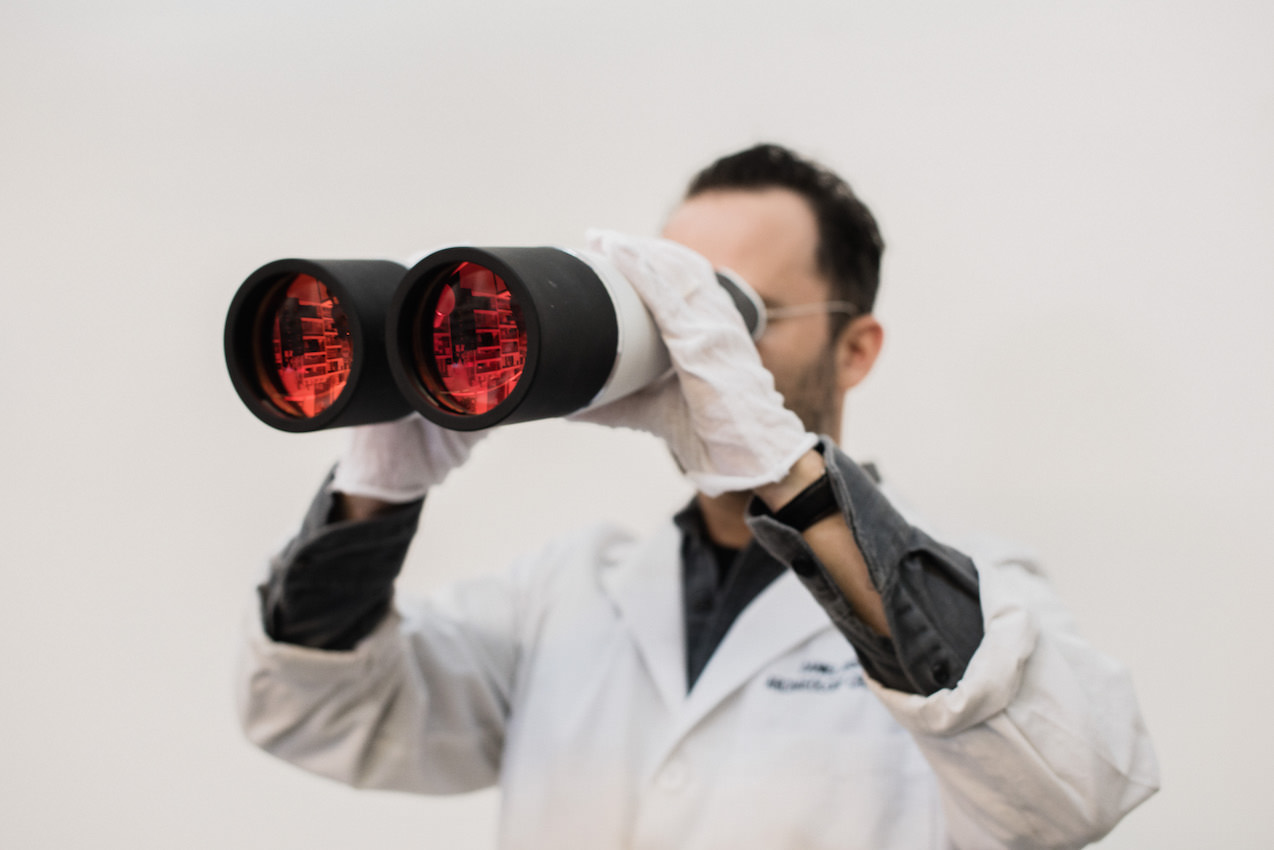
Photo by Shawn Brackbill
Material is also “super-important,” to Arsham. Since that first eroded ash-Pentax, he’s created thousands of future archeology sculptures using exclusively geological materials. “Things like volcanic ash, crystal, and obsidian make us think about time.” Slipping on a pair of white gloves to examine a crystal iPhone needing his approval, Arsham described his work as intentionally disorienting. “People expect an archeological object to be from a time they’re not actually present in. When they’re looking at a cast of their iPhone that’s eroded and made out of ash, the viewer considers either that they’ve been transported to the future to see this object that is part of their lives now, or that the object has been brought back to their present from the future.”
Arsham imagines that future all the time. For the past few years, he’s been working on his first film. He’s released two of the nine installments comprising The Future Relic online. Starring Arsham and pal James Franco, respectively, both chapters unfold like premonitions in the artist’s eerie postapocalyptic world. “The entire film began because I realized when I was exhibiting the future archeology pieces, people were trying to picture the future in which these objects exist. I figured I could sort of direct that narrative, so I wrote a script.”
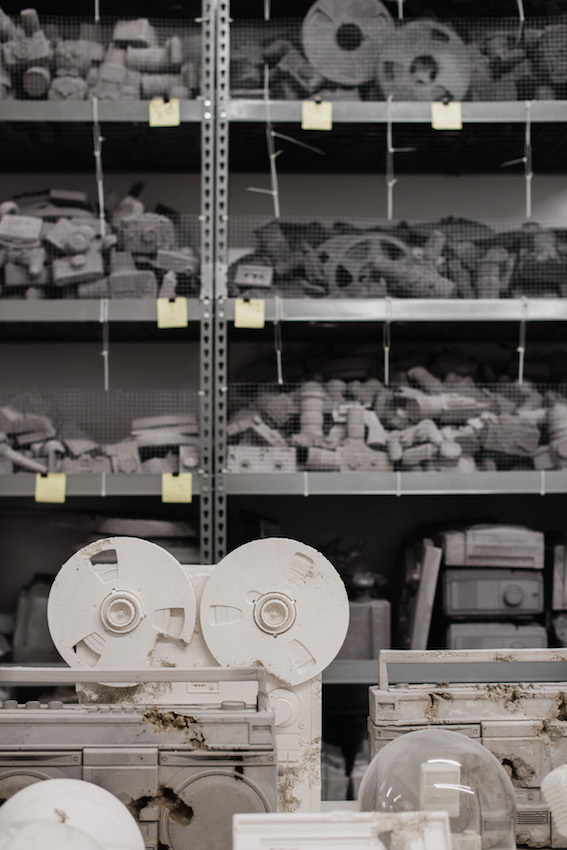
Photo by Shawn Brackbill
He’s also creating all the props for the films. While they’re not for sale, he will barter them in exchange for an actor’s participation in a chapter of the film (as he did with Franco and Juliette Lewis). Fortunately for collectors, with each installment of Future Relic Arsham will produce an edition of corresponding sculptures, which will be released simultaneously to their cinematic counterpart. The entirety of The Future Relic will roll out over the next two years. The first four chapters will be screened together at the Tribeca Film Festival in April, and the remaining five at TFF in 2016.
Of course, he’s promoting the project on social media. With nearly 180,000 followers in the bag and “a thousand new followers every other day,” it’s hard to deny the appeal of the platform. “More people see my work on Instagram than anywhere else. My followers include all the people who go to an exhibition, and thousands who don’t. Maybe they don’t have access, or are intimidated, but for whatever reason there are people following the feed who have probably never been to a gallery or a museum. And that’s super-important to me. Instagram is a way for me to have a sort of more egalitarian practice.” “Sort of” is right. Instagram isn’t exactly a level playing field. Few artists can claim to be boys with Pharrell, whose comment “I love dis man” brought Arsham four hundred new followers in an hour. Regardless, visual social media platforms support sales of art by generating a steady buzz around artists, openings, and, recently, auctions. For multidisciplinary artists like Arsham, who work in performance, film, and temporary installation, these outlets provide that work a wider audience than ever before.
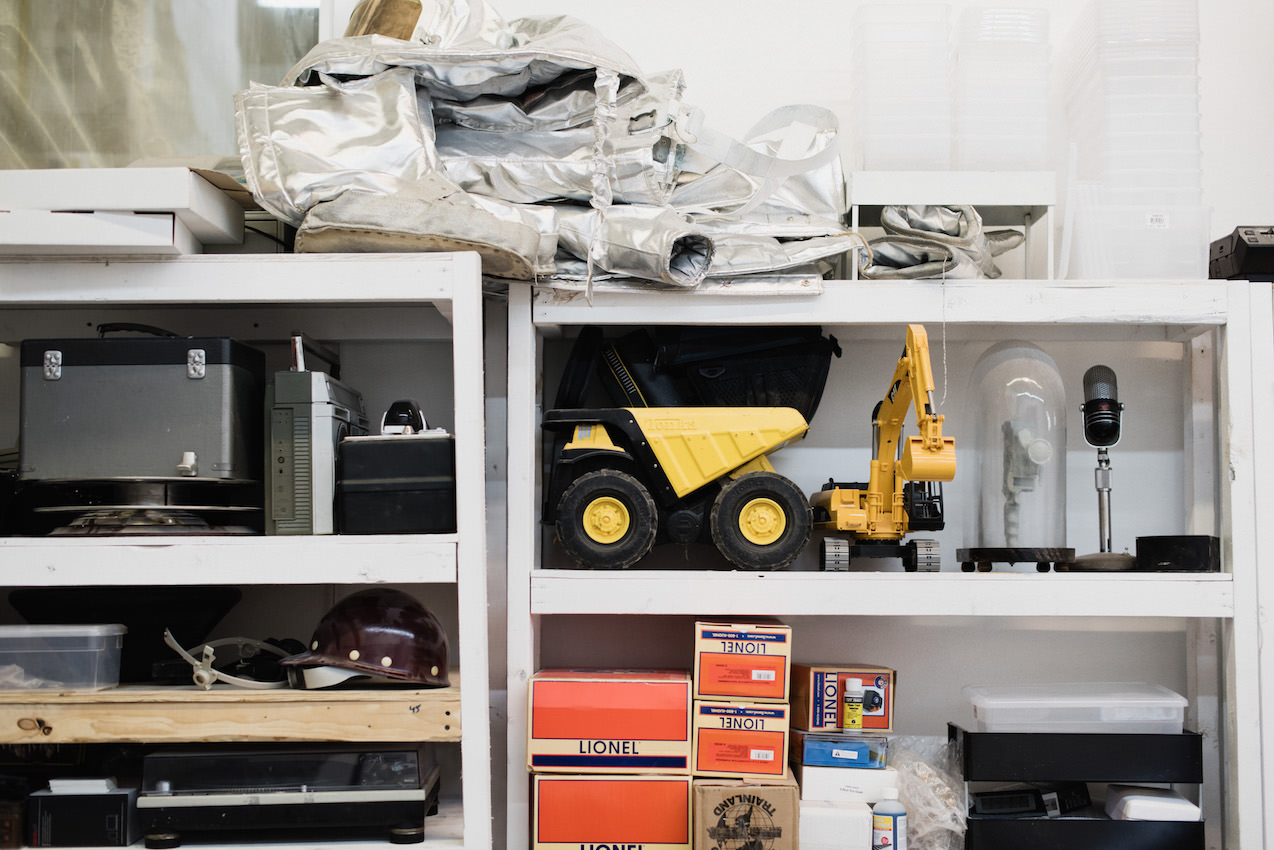
Photo by Shawn Brackbill
Photography, then film, allowed art to be reproduced, preserved, and distributed through the channels of mass media. With the advent of the Internet, smartphones, and image-driven social media, to say art’s reproducibility has grown exponentially is an understatement. In fact, images of most of the world’s art objects now live online—in perpetuity.
Growing up in the nineties and coming of age as an artist in the aughts, Arsham witnessed the age of mechanical reproduction morph into the digital age, simultaneously collecting the instruments of visual preservation, which would come to represent that shift. He understands the analog-digital irony contained by an image posted on Instagram (a contemporary distribution channel) of a sculpture of a Polaroid camera (a vintage tool of artistic preservation), which has supposedly existed in the future. He speaks his own visual language fluently and plays with concepts of time, space, and preservation in the digital age, across diverse media, with conceptual and technical adroitness.
Every bit the mature millennial artist at 34, as he stood up to say goodbye, Arsham left me pondering the semiotics of my iPhone. “Look at the Mitchell movie camera.” He motioned toward the largest piece in the collection. “Doesn’t it look like the emoji of the movie camera?”
It totally did.
This article was first published Whitewall’s spring 2015 Art Issue.








